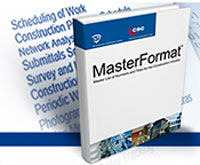The Construction Specifications Institute (CSI) is the organization that publishes the MasterFormat. This publication is the specifications-writing standard for most of today’s construction and commercial building design projects in North America. Basically, the MasterFormat is an indexing system for the organization of construction data. The information is organized in title divisions, such as electrical, mechanical, procurement and contracting requirements, HVAC and thermal protection.
Although its earlier publication comprised of 16 divisions of construction, it has expanded to 50 divisions to reflect the current complexity of the construction industry along with the need to incorporate maintenance information and facility life cycle information. The divisions in the MasterFormat are structured for both future growth and expansion. Those in the construction industry are even encourage to propose revisions to CSI. You might say that the MasterFormat is a continual work in progress and constantly evolving.
Advantages of the CSI MasterFormat
Standards are needed to improve coordination and facilitate communication among all workers in the construction project, including architects, suppliers, engineers, project managers and energy consultants. The CSI MasterFormat is the standard maverick which helps everyone stay on budget, develop timelines, meet deadlines and meet building owner’s requirements. It’s also important for you to realize that with the automation increase in the construction industry, the CSI MasterFormat is vital to achieve meaningful interoperability. It helps every discipline involved in the design, building and operations of construction applications, whether it’s a hospital or elementary school.
The MasterFormat also helps contractors and architects work on additions in the future and renovations. The data can be easily retrieved. And with the increased use of building information modeling (BIM), the MasterFormat is a good fit. More and more, modeling software systems are using MasterFormat’s format for BIM integration.
Where the CSI MasterFormat is Being Used
Today, the CSI MasterFormat is used in a wide range of industry construction, such as hospitals, schools, industrial and commercial green buildings. Think about it. Hospitals and other healthcare facilities are complex. The security, back-up power, HVAC, medical gas and other systems are more complicated that the traditional institutional building. With so much on the line, it’s critical that the building will perform properly for both healthcare workers and patients. For healthcare facilities, the CSI Master Format has a series of sections specifically dedicated to the HVAC in healthcare facilities. For green building, there are environmental performance requirements that cover topics, such as indoor air quality and sustainable design.
Responding to Industry Changes
The CSI MasterFormat is generally updated every five to seven years. As a matter of fact, the 2004 Edition looks nothing like its previous 1960s counterpart. Part of the reason for the 2004 Edition was due to the importance of building electrical systems and the need for a new division for telecommunication systems. New divisions included Division 21 Life-Safety Systems and Division 25 telecommunications systems. The Division 40s was assigned to waste treatment and power systems. Since then, CSI has updated improvements to the section for polished concrete under Division 3. The MasterFormat is designed to respond to industry changes, improvements and new technologies. If you’re not using it, it’s time to jump onboard.
Sources
Featured image from: http://www.masterformat.com/
http://www.archtoolbox.com/representation/specifications/csidivisions.html
http://www.hconews.com/articles/2011/03/21/the-benefits-masterformat
http://www.facilitiesnet.com/designconstruction/article/New-Technology-Brings-Changes-to-Venerable-Construction-MasterFormat-Facilities-Management-Design-Construction-Feature–1397


